Beautiful indoor plant, clivia, differs not only by spectacular long-lasting flowering, but also beautiful dark green leaves. Unpretentious in leaving the culture still has a number of features and preferences, the ignorance of which can lead to negative consequences: Clivia does not bloom, will "be sick" or will die at all. So that such trouble happened before growing a perennial, you should familiarize yourself with the information below. All about landing and leaving the room flower, clivia, in this selection of material.
Houseplant Clivia: the description of culture
- Clivia plant refers to a perennial herbaceous crops of the family Amaryllidaceae. Home to the genus of evergreen Clive considered South Africa.
- Famous botanist John Lindley called the flower of the honor of the Duchess Charlotte Clive, British governess future queen, who loved flowers and was fond of them breeding.
- Flower reaches adult height of about 60 cm. As such, the stalk at Cleve offline. Radical vaginal clivia leaves tightly pressed against each other "fan", forming an outlet and forming a false stem. Ensiform shaped leaves are painted in rich, dark green color. Mean flower size sheet adult Cleve comprise: length - from 45 to 75 cm in width - from 5 to 8 cm.
- Stems from Cleve can form multiple, and the older flower, the greater will be the flower arrows. Mature and well-developed specimens of plants are able to "produce" up to 50 stems at a time. In height they reach about 30-40 cm, with thick caked with flowers.
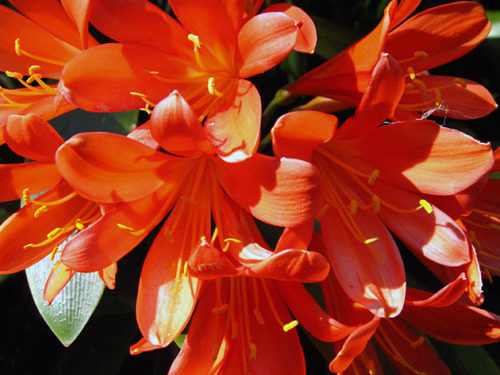
- Perennial flowers funnel shape, medium size (20 cm in diameter) are collected in the dense (up to 60 flowers) inflorescences umbrella. Color beaters such "bells" diverse. There are varieties with flowers of orange, yellow, red, pink or mixed colors.
- Due to alternately blossoming flowers in the inflorescence, flowering clivia lasts till 3-4 weeks. After flowering berry formed.
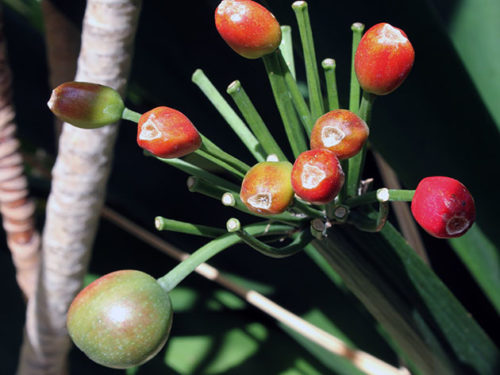
- When flowering Clivia? Perennial blooms usually in the winter, but with proper care of plants, clivia is able to bloom twice a year.
- Clivia is a rather unusual root system represented thickened and entwined with each other fleshy roots. This genus of plants occupies an intermediate (between the bulb and this root) form the structure of the rhizome. Due to the ability to store water and nutrients, the rhizome looks rich and powerful.
- Indoor flower clivia is most often represented a form of cinnabar ( "Miniato") or excellent ( "Nobilis") Cleve.
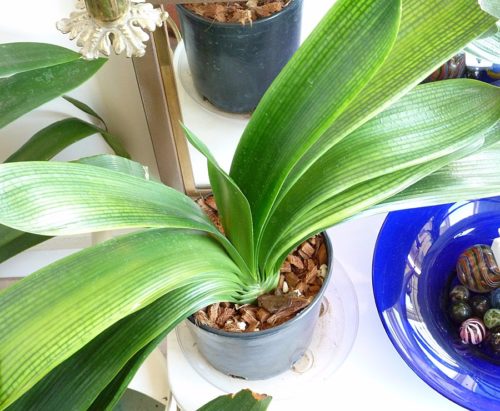
Houseplant clivia: features of culture
- Blooming Clivia is an unusually beautiful sight: glossy, dark green, large leaves with bright thick multi-flowered inflorescences. Even when the plant does not bloom, it looks spectacular in any home or office interior due to elegant shiny leaves.
- In addition to its decorative purpose, the room flower Clivia is used in pharmacology (as an painful agent). It is important to know that the leaves and roots are toxic and poisonous, therefore it is not necessary to deal with self-treatment at home. Alkaloid contained in the plant, lycarin, is able to induce vomiting and even paralysis. In this regard, after working with a flower, it is necessary to wash your hands.
- Features of tropical origin of the plant allow you to designate the main preferences of the home flower: scattered light and moderate importance. The best flower "feels" yourself on the eastern, western and northern windows.
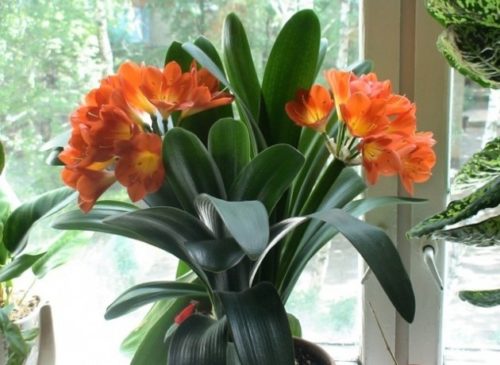
- In the winter, unlike most houseplants, clivia needs rest. At this time, the pot with a flower is rearranged into the cool room so that the perennial "gained strength" before the upcoming flowering.
- Clivia "does not like" tightness, so the potted culture should provide sufficient space and space.
- In addition to the "free zone", evergreen clivia reacts poorly if it is often rearranged or disturbed. The culture is worth only as needed, choosing not too spacious pot. Clivia roots are more comfortable in a close container.
- To grow a large clivia flower, forming numerous blooms, it is not worth separating it (multiply) or remove the resulting offspring.
- Homemade clivia is considered a real long-liver and under favorable conditions can grow up to 30-40 years.
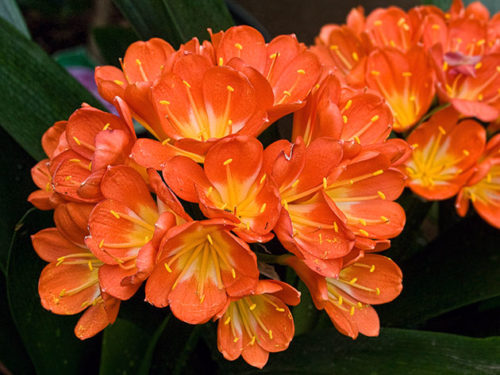
Clivia, varieties and varieties for home conditions
At home, three types of clivia are grown:
- Clivia Gardenii (Clivia Gardenii). The height of the flower is as well as a bloody, no more than 50 cm; Dark green sword-shaped leaves are pointed at the ends. Bell talid flowers of red, up to 15 pieces in inflorescence. Blossom comes in winter.
- Clivia is beautiful (Clivia Nobilis). The belt prominent leaves reach a length of no more than 40 cm, the blooms are slightly longer (up to 50 cm). The inflorescence forms about 50 blasting flowers of a purple shade with a novel at the ends of the petals. Flowering falls on the second half of winter - spring.
- Cynic clivia (Clivia Miniata). This type of clivia is considered the most common in flower growing. The leaves are reached in length about 70 cm, have a dark green shade and a removal shape. Flowers Clivia Cinnabulae in spring, forming on one floral arrow to 20 yellow-orange tint flowers. The view is used to remove new varieties of clivia. One of the most famous cultivated varieties is called Clivia Variant. This form has become the basis for obtaining many varieties, such as: "Japanis Pastels" (cream flowers), "Streap" (orange flowers and striped leaves), "Solomon Hello" (Yellow flowers), "Snowubol" (white flowers), "Milk White" (Flowers of a dairy pink shade), "Myopic Hurt" (white with pink edges of flowers).
Clivia, landing and transplanting at home
So that the bedroom clivia successfully passed on and pleased with annual beautiful blossoms, it is important to put a plant correctly and replant the perennial only as needed.
Landing Clivia at home
- Choosing a pot for planting a clivia flower is important to make sure the drainage holes so that the water is subsequently stored, and the air can freely circulate to the roots.
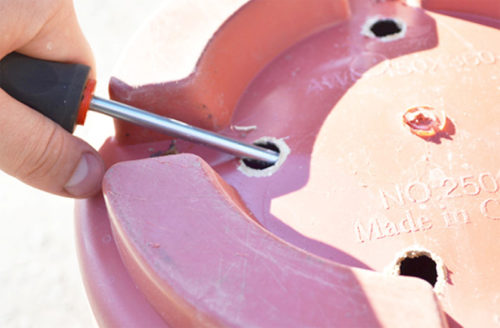
- At the bottom of the pot first laid a layer of drainage. For these purposes, it is possible to use clamzit, pebbles or small crushed stone. The drainage layer provides the necessary humidity level for indoor flower. The thickness of the drainage "pillow" is approximately 1 \\ 4 part of the pot.
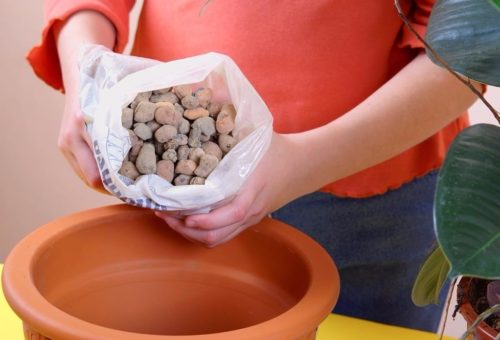
- The next step is the preparation of the soil mixture. The most optimal soil for clivia is loose and lightweight, with a weakly acidic medium reaction. If the mixture is prepared independently need to take in the same fractions of leaf, turf and sand (or perlite). For young plants of sand (perlite), you can add a slightly more, thereby increasing the grounding of the soil. Buying soil, you should stop your choice on the soil for orchids, the composition of which is most suitable for fleshy and gentle clivia roots.
- The finished soil before landing is disinfected to protect the future flower from possible diseases or pests. This can be done in different ways: shed a non-concentrated solution of manganese or boiling water, warm up in a very hot ovens for at least 10 minutes or put in a microwave oven for 3-4 minutes (at maximum power). Chemicals for soil disinfection are undesirable, since chemically active substances will destroy together with unwanted bacteria and the useful soil microflora.
- It is recommended to add 20-30 g of phosphorus-containing fertilizers (for example, superphosphate or phosphate flour) to the prepared dispenseed soil. Phosphorus will significantly improve the nutritionality of the soil mixture.
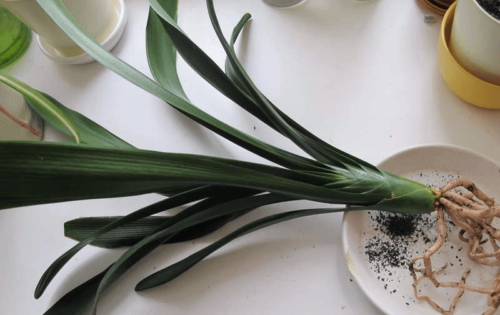
Clearing Clivia at home
- Considering that clivia does not tolerate excessive intervention, it follows the indoor flower only in case of extreme necessity. Such a reason can be the insufficient size of the flower pot, when the roots of Clivia in the literal sense will begin to "get out" out.
- The plant transplant (more in the size of the pot) must be carried out by the transshipment method, while maintaining the natural self.
- Before transplanting the room clusion, the flower in advance (in 2-3 hours) is spilled by water.
- Then, neatly removing the plant from the pot, put it in a new container (with a prepared drainage and soil layer). At the same time, the roots of the young clivia recommend gently rinse and view. In case of detection of damaged or rotten roots - they are removed. The locations of the sections and the roots of the roots are sprinkled with crowded coal, so that it does not occur at all the rhizomes.
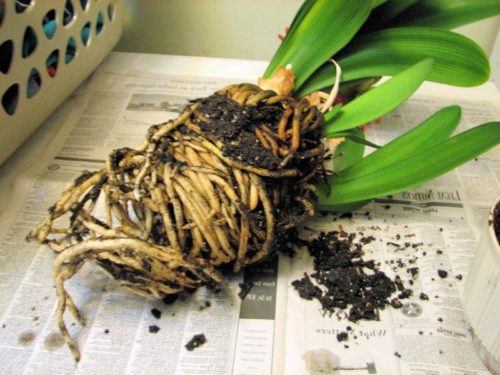
- By placing a plant in a pot (on a layer of soil about 5 cm), soils fill all the emptiness to its very edge. With proper landing, the root neck of the plant must be slightly above the soil level. Otherwise, the bottom of the lower leaves can begin.
- Transplanted room clivia only after the end of flowering, but not more than once every 2-3 years. Plants older than 10 years do not recommend replant. For them, it will be enough for an annual update of the upper layer of soil, at least 5-8 cm. Young specimens are allowed to transplant more often (annually), subject to minimal injury to the fragile root system.
- When transplanting a young plant into a new, larger pot, it is important to choose a not very large container for a flower. It is enough to choose a pot on 3-4 cm wider than the previous one. Too spacious container reduces (and sometimes it makes it impossible) Perennial blossom. Only after a certain time, when the roots rise sufficiently, the clivia will reproduce with bright inflorescences.
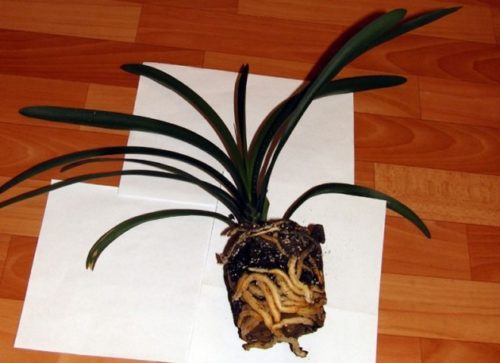
Clivia, home care
Before proceeding with the description of the basic rules of care for homemade clivia, it is important to recall the poisonous properties of the plant once again. Therefore, after working with a flower, it is necessary to wash your hands so that the juice of the plant will not get inside the body. Emergency consequences of the minor amount of juice into the gastrointestinal tract, of course, will not, but nausea, vomiting or diarrhea may occur.
So how to care for clivia at home?
Consider key requirements and preferences of many years of culture. Observing all the rules below, the flower care will not cause difficulties and will not be burdensome.
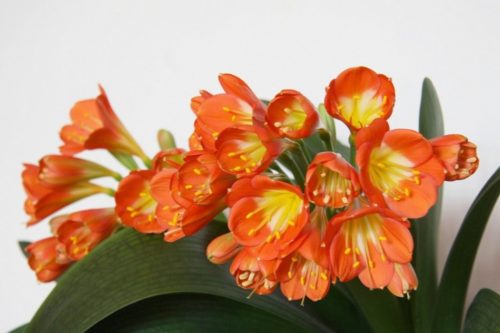
Lighting and temperature regime for clivia at home
- The best lighting for clivia is scattered light. Therefore, it is best to place a pot with a clivia flower on the windows of Eastern or Western side. The northern part of the house is also allowed, but in case of insufficient lighting, clivia will develop slowly and may not be bloated. The windows on the south side are usually not suitable for perennial, suffering from the abundance of direct sunlight. If the flower pot is left on the south side, you need to provide the flower shading.
- In the summer, room clivia is recommended to exhibit on fresh air (street or balcony). The main thing is to choose for evergreen "Beauty" protected from drafts, outdoor sun and precipitation, place.
- For the successful growth and development of the flower, it is important to observe the optimally acceptable and favorable temperature regime. In the warm season, the temperature in the house where Clivia is located, should be from 20 to 25 0C. Autumn, on the eve of the winter period, the temperature is reduced to 14-15 0S. The same figure is appropriate and in winter, during the rest of the clivia plant. The most successful version of the flower placement at this time is a glazed unheated loggia. In case of the appearance of a bloody, the plant is placed again in a warmer place with a temperature of about 20 0WITH.
- Not compliance with the temperature regime plant will not destroy, but the likelihood of the slow motion development of the flower and the lack of desired flowering flowering is large.
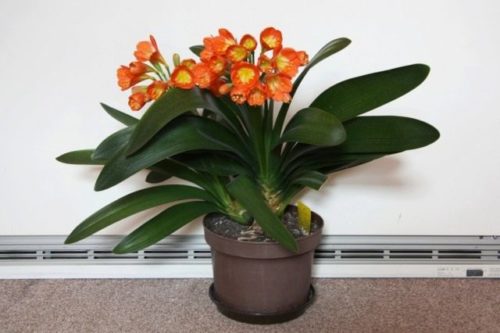
Watering and spraying of clivia at home
- Watering of clivia is carried out by soft watering water.
- Watering a multi-year flower follows moderately so that the water is not stored, but the soil did not stop much. A sign of the necessary moistening can serve a slightly filled soil in a pot.
- Excess water flowing into the pallet, it is necessary to pour. Stagnation can trigger the root of the flower roots.
- During the flowering of clivia, the watering is increased, and the water takes a slightly warm.
- But during the period of rest, on the contrary, irrigation rates reduce, moisturizing the soil is not more often once every 10-12 days.
- To spray the lytology of Clivia is optional, the plant is relatively indifferent to the level of humidity. The only thing is to periodically wipe the leaves of clivia from dust and pollution.
Cleaning and fertilizer of clivia at home
- Clivia responsive to additional feeding, significantly improving its decorative attractive appearance.
- Cleaning clivia is carried out in the period of active vegetative development of the flower (chose of flowerons and flowering).
- Fertilizers are starting after the first picking of the plant twice a month.
- Mineral complexes are suitable for nutrient feeders (2 g per liter of warm water) and liquid organic fertilizers. They are recommended to alternate.
- Among the mineral complex fertilizers, ammophos, "nitroposk" or "Kemira" are most often used.
- From the organic, the most preferable use of biohumus, such as "ideal", "cormalets", "gigid" and others. Dosage of dilution of the means on average is 1 tbsp. Fertilizers per liter of water.
- Excess nitrogen in feeding stimulates the growth of green mass, but can prevent repeated flowering of clivia.
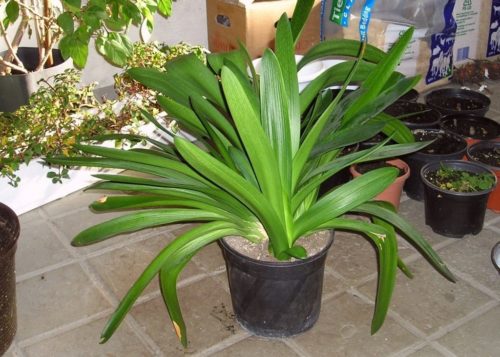
Fighting diseases and pests of Clivia at home
- Insect pests are not so often annoyed by a room clivia. As a rule, they appear due to the use of infected soil. That is why it is so important to disinfect and disinfect the soil before planting the plant.
- Occasionally, the flower may be affected by pests such as a shield (shield rate) and a torment cherry.
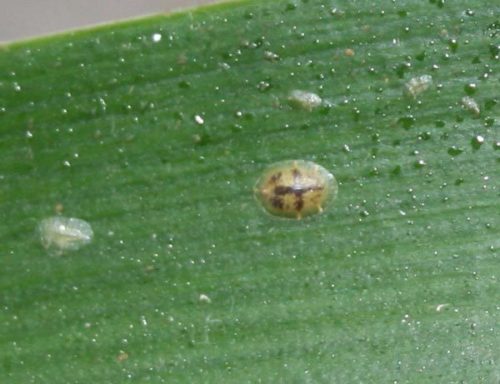
- The boards suck the juice of the plant, leaving behind the brown plaques in the leaves. Subsequently, the affected parts of the plant pale and dry out.
- Mute Cherberry parasitates on all overhead parts of the plant: leaves, flowers and flowers.
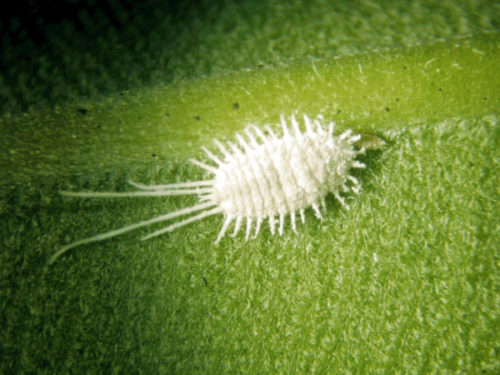
- To combat pests, the flower leaves are wiping with soap solution, after which the entire plant spray with a 15% accuteral solution.
- As for diseases, Clivia may "suffer" from some fungal infections appearing, as a rule, as a result of incorrect roommate.
- Excessive moisturizing can provoke the development of gray rot, manifested by brown spots on the flower foliage. For treatment, fungus use burglar liquid or copper-containing preparations (for example, copper sulphate).
Useful tips on growing room clivia
- Cleaning period of clivia.
For the successful development and flowering of clivia at home, it is important to provide a plant with a natural period of peace during the cold season (the second half of the autumn is winter). The room temperature should not be lowered below 12 0With so that the plant does not die. The older the flower is the greater he takes the period of rest. For young plants, it is enough for 2-3 months, it will take 4-5 months for mature instances. At this time, the temperature is reduced in the room, the flower is not feeding and almost not watered. The rest period is very important for clivia, since the plant is gaining strength for the upcoming flowering.
- Cleaning flowering period.
The appearance of a flower arrow (in the rest period) signals the need to change the conditions of the room flower. The plant provides increased medium temperature, good lighting, watering warm water and feeding. These activities begin to be carried out when the flowers reach about 15 cm long, otherwise the arrow may dwell. When clivia blooms, you should not disturb the plant once again: to rearrange or rotate the pot, wipe the leaves, loosen the soil, etc. If the pot had to rearrange, it is important to put it on the initial direction of the growth of leaves and buds, so as not to stop their further development or fond. After flowering, the flowers are cut.
- Repeated flowering of clivia.
To achieve re-flowering, you need to artificially symitize the onset of rest period for many years of culture. To this end, in the summer, after relaxing in the fresh air, the clivia is entered into a prieved room, cutting watering and do not use feeding. After about 1.5-2 weeks, the lower leaves lightly yellow, and the plant will release the floral arrow. In the color saw phase that has reached 10-15 cm, the conditions of the content change again. Repeated bloom is possible only in adult and well-developed instances.
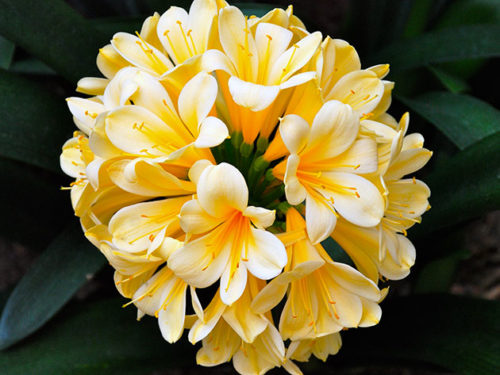
Problems when growing clivia at home
Not compliance with the conditions of the content of the room plant can lead to some problems or difficulties. Consider the most common difficulties in leaving a perennial. By eliminating the reasons designated below, it will be easy to achieve full recovery of the plant.
- Why doesn't clivia bloom?
Causes of lack of flowering can be somewhat: indoors are too high or low temperature, insufficient illumination, lack of moisture and nutrients, a short or incorrectly organized period of rest, excess nitrogen fertilizers, a spacious flower pot.
- Why not grow stems Cleve?
Short flower arrow may indicate a lack of irrigation, low temperature state (during the active growing season), a prolonged period of rest. Changing conditions and irrigating with warm water (40 0C) tend to encourage further "awakening" and the flower stalk development, education anticipated buds.
- Why do leaves turn yellow Clivia?
Clivia leaves may turn yellow as a result of contact with direct sunlight, causing burns. In addition, yellowing of the foliage may occur due to insufficient or excess moisture, lack of nutrients, as well as after transplanting plants, "painful" acclimation period and rooting.
If yellowing lower leaves CLW and it happens in the rest period the plants - this is a normal physiological process, without threatening long-term culture.
- Why do leaves turn pale Cleve?
The intensity of the color (blanching) leaves may change if the plant lacks nutrients.
- Why dry leaves Cleve?
Clivia leaves often dry up due to excessive waterlogged soil.
- Why clivia leaves resets?
Most often, the cause defoliation is a lack of moisture.
- Why clivia leaves have spots?
If the leaves appear bright spots - a sun-scorch Cleve, the presence of brown plaques indicative of parasitizing on the indoor flower scale insects.
- Why rot the roots of Clivia?
root rot - a consequence of excess moisture flower absence drainage layer or the drainage holes in a flowerpot.
Reproduction Cleve at home
Grow cleave can be independently in several ways: from the seeds, rhizomes or division of lateral shoots, the so-called Clive children. The second method is considered to be among the growers more easy and affordable. In addition, clivia, grown in such a way will bloom much earlier than from seeds.
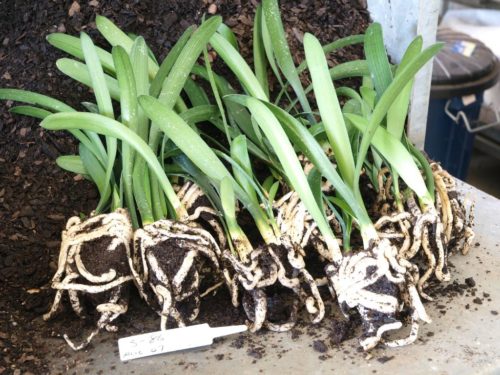
Reproduction clivia from seeds at home
- To get home clivia seeds have to resort to artificial pollination of flowers. If the skills of such a procedure is not, it is better to buy seeds Clivia in a flower shop.
- Fruiting depletes the plant, so in this period must be increased attention to the flower (watering, fertilizing). Ripened fruits Cleve change color from green to red, and become soft. It shows a complete maturation and ability to collect seed.
- Seeding is carried out in spring or autumn. Before planting the seeds are soaked for a day in the water.
- After swelling, the seeds are sown in a light soil container. It can be a mixture of peat and perlite or sand and a turf.
- Seeds are plugged into the soil no more than 1 cm. The interval between seeds is about 2 cm.
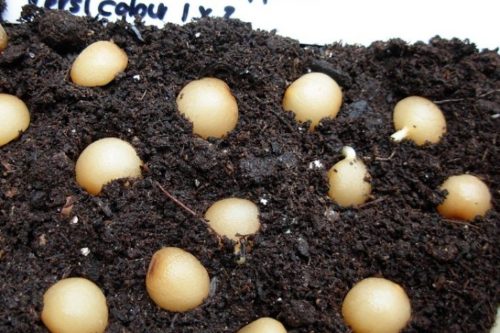
- The container with seeds leave in heat (20-25 0C) indoors, ensuring moisturizing and venting.
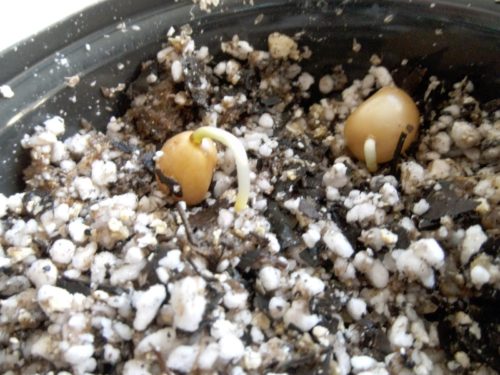
- In the phase of the first sheet, seedlings are picked by individual pots (cups), with a diameter of no more than 7 cm.
- Each year, seedlings are transplanted (by transshipment) to pots, slightly more (about 3-4 cm) size.
- Cleaving seedlings grow slowly, and the plant blooms only for the 5-6th year after landing.
Plugulation of clivia side shoots at home
- Plugulation of clivia with young lateral shoots is the most convenient exercise during the transplantation of the plant.
- For this, neatly, without damaging the fragile roots of the mother plant, separated lateral processes - kids clivia. Suitable for landing will be babies with developed 4 leaves.
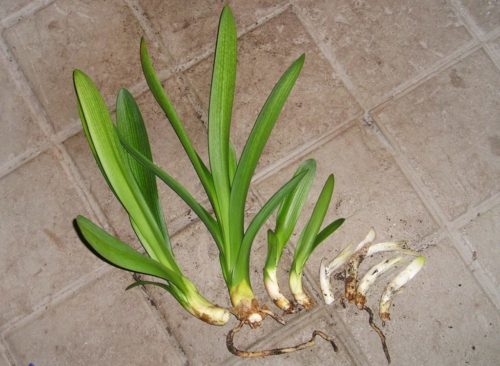
- Young plants are planted into separate pots, with a diameter of no more than 7-8 cm, and the first time is watered very moderately (rather even poorly).
- Already 2-4 years after landing, climbing clouds will bloom.
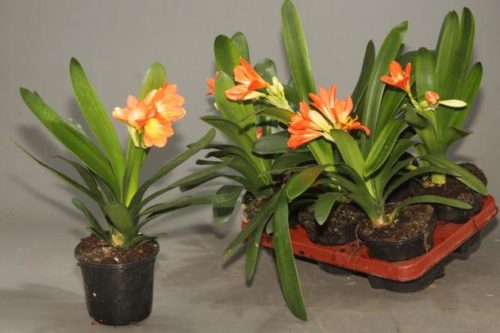

Reproduction of Clivia Rhizome House
- When transplanting a mature plant of clivia, one can carefully divide its rhizomes for further reproduction of the plant.
- The separated landing part of the root is planted as well as side shoots. Cuts of the roots before planting are necessarily treated with coal, otherwise the risk of reloading the root system is great.
- The first few days after landing the pot does not watered at all and only after this time begin to moisten the soil gradually.
- The flowering of successfully rooted parts of clivia will begin 2-3 years after landing.
Multipling clivia, it is important not to create for young plants the period of peace for the first 2-3 years. They must intensively increase the green mass, accumulate nutrients to subsequently provide abundant and long-lasting flowering.

Thus, a room clivia flower is a spectacular and beautiful plant requiring certain content conditions. Observing all the rules for the care of many years of culture, the flowerflower will easily "get used to" to the peculiarities of this culture, providing bright flowering of clivia twice a year.

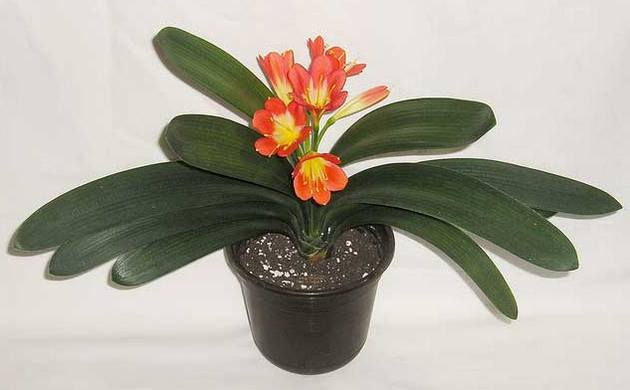
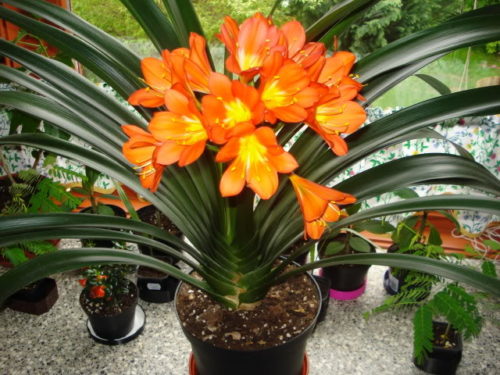
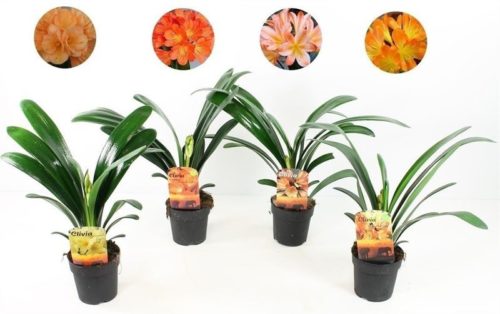
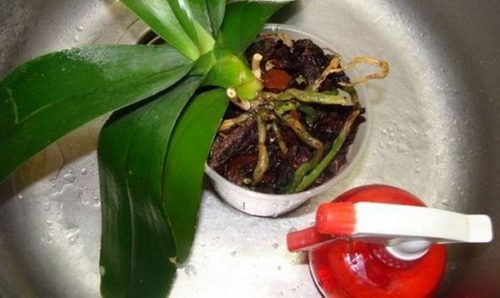
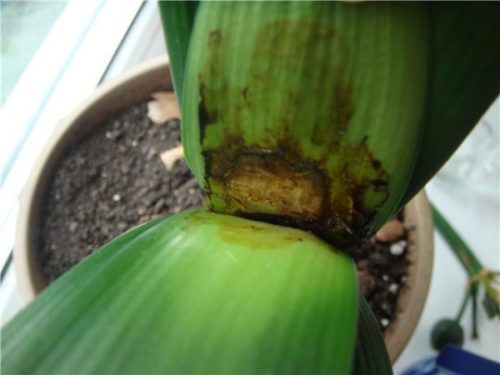
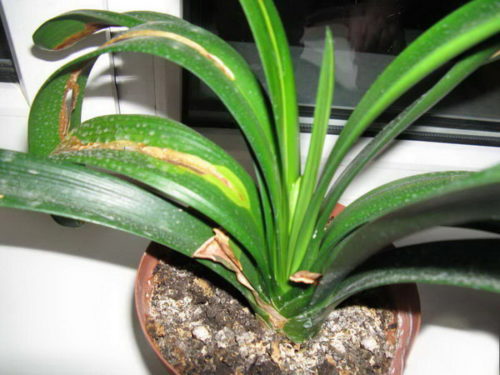
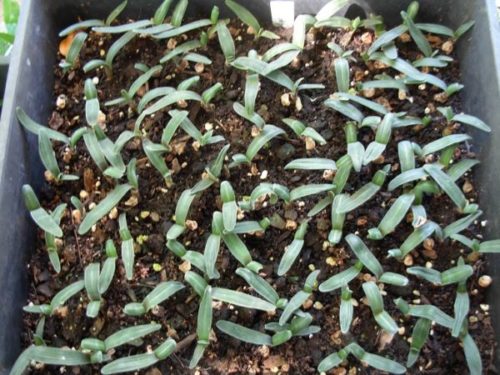
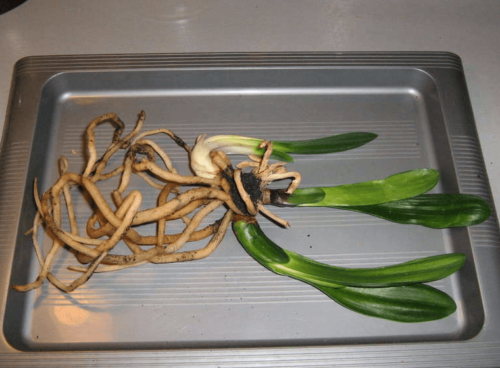
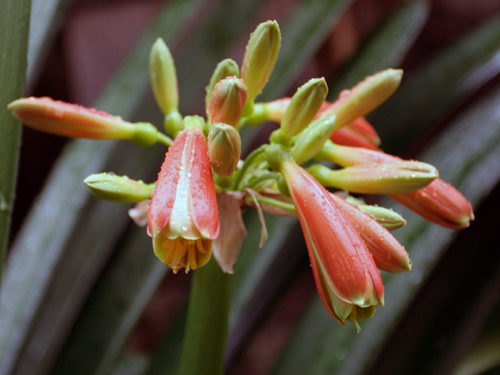

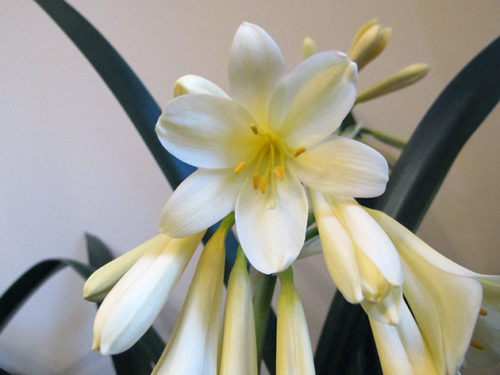
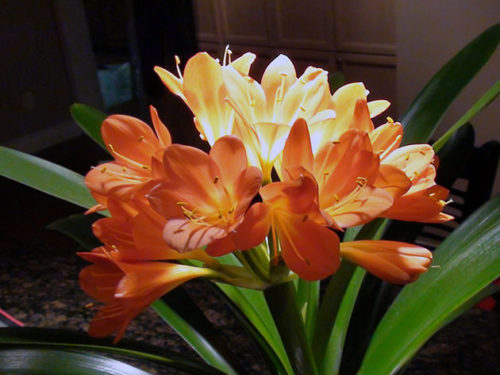
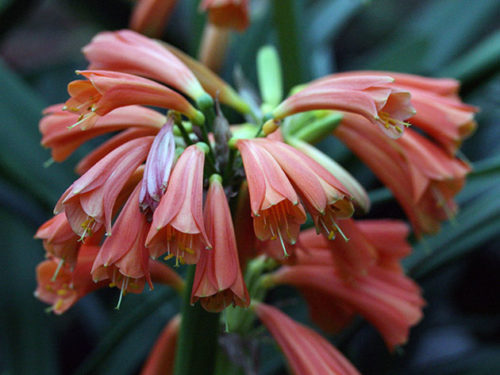
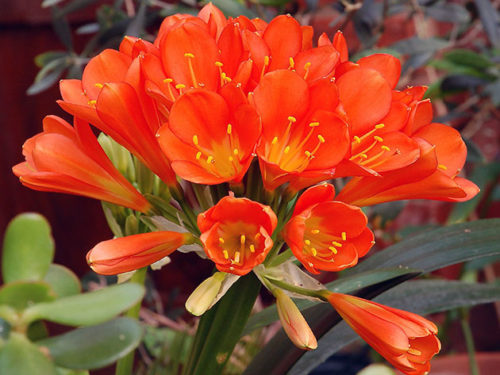
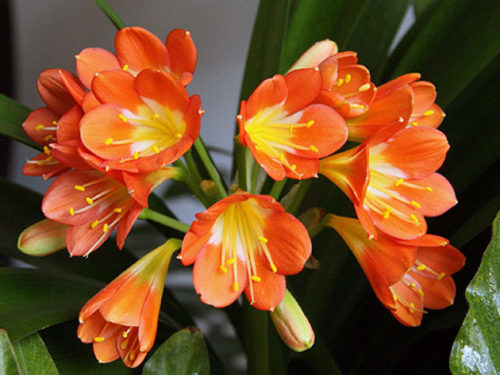
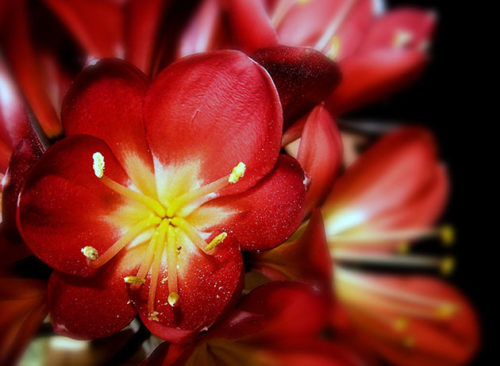
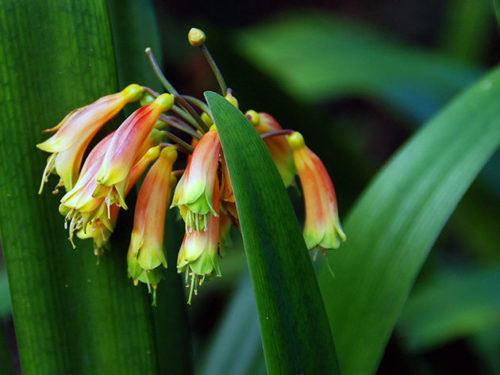
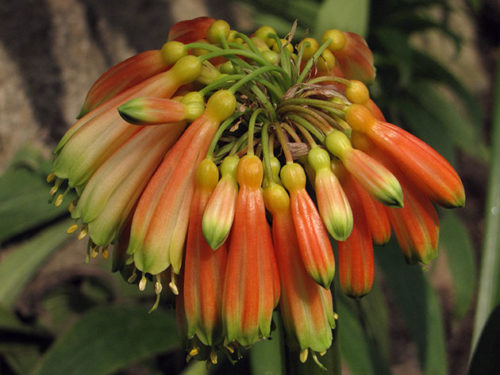
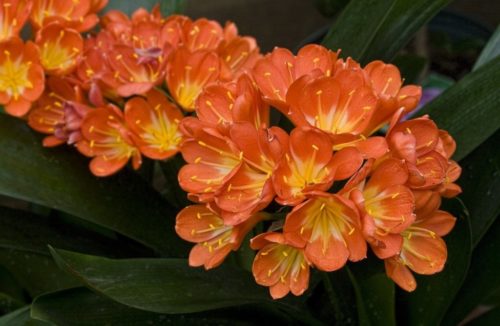

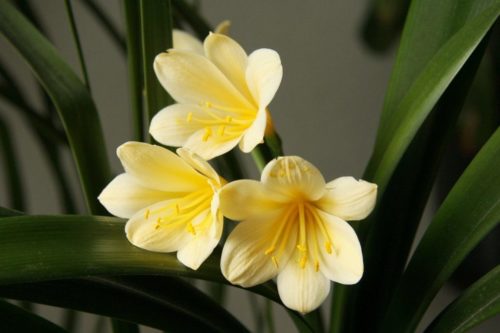
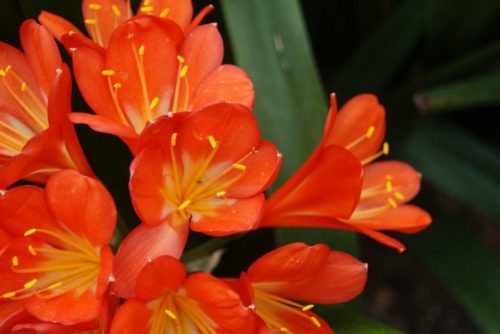
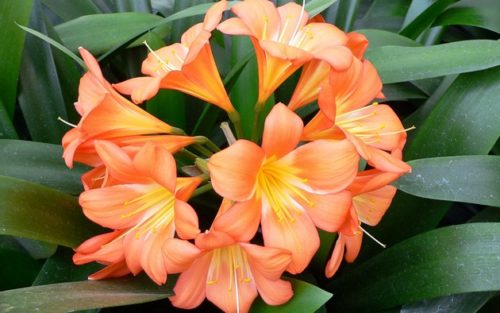
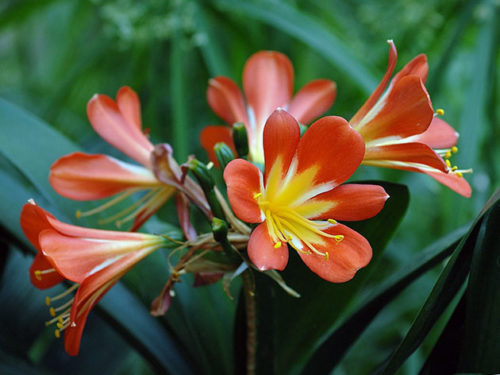












 Start a discussion ...
Start a discussion ...